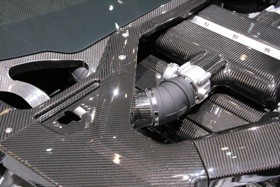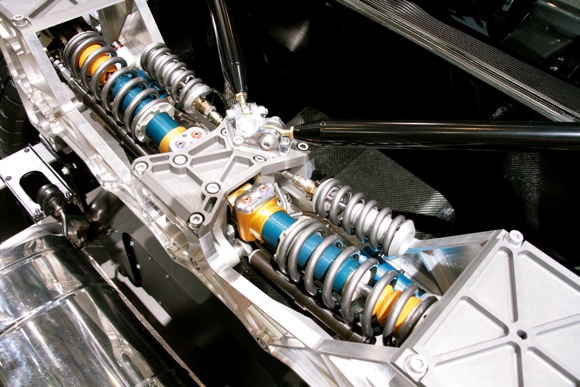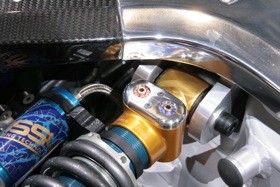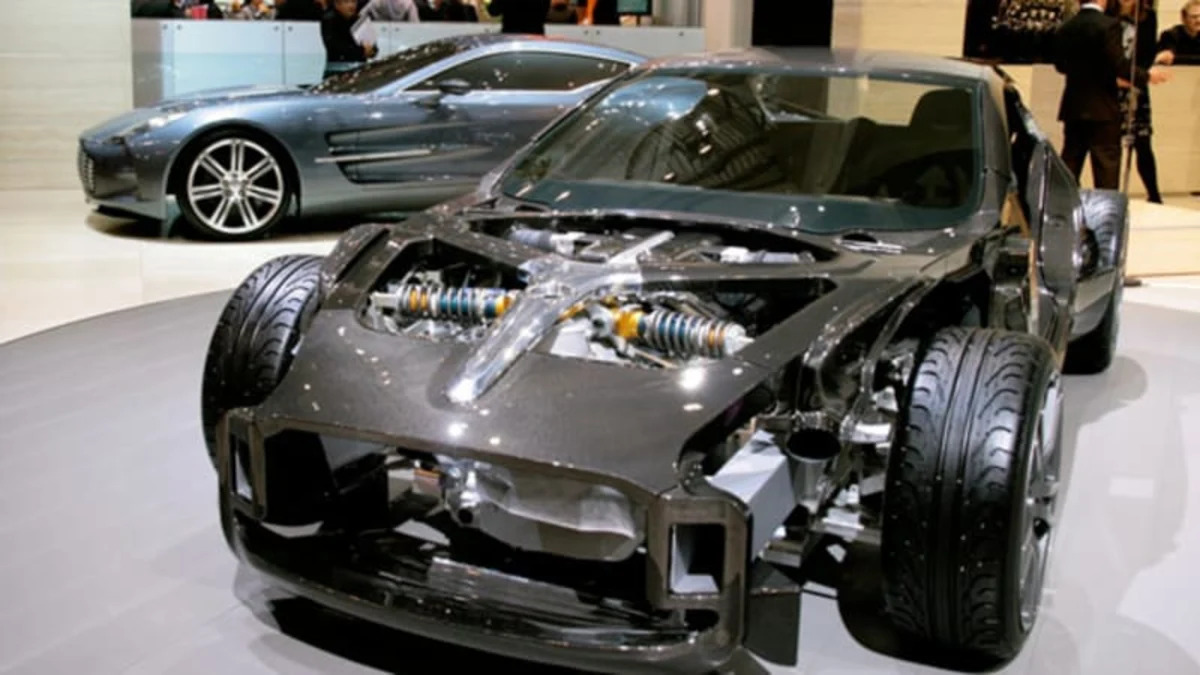Aston Martin One-77 internals - Click above for high-res gallery
At the Geneva Motor Show this week, Aston Martin publicly showed its limited-edition One-77 super-car for the first time. While the design is certainly attention grabbing, the machinery sitting next to it was perhaps even more so. On the first of two press days, the Aston stand was dominated by the first complete One-77 chassis laid bare for all the world to see. Resplendent in carbon-fiber and cast, forged and extruded aluminum, the skinless One-77 is an engineer's dream.
Chris Porritt, Chief Program Manager for the One-77, took a few minutes to give us a guided tour of this remarkable example of engineering art. The mechanical bits of the One-77 are built more like the guts of an Le Mans Prototype racer than any typical production car. Of course, calling this a production car is a stretch anyway given that only 77 examples will be produced. Major automakers typically produce more prototypes than that for a new vehicle program. Follow the jump for a walk through of the One-77.
Photos Copyright ©2009 Sam Abuelsamid / Weblogs, Inc.
A high-performance car relies on several key elements. Obviously, a great propulsion system is a prerequisite and the One-77 has that, but we'll come back to that later. Large quantities of power don't mean much without a chassis that's able to manage the dynamics of spirited driving. Doing that requires keeping the rubber in contact with the road at all times and knowing where the wheels are relative to each other. That requires a rigid structure that minimizes the physical motion of the suspension mounting points as the car corners, accelerates, brakes and follows the contour of the road.

Ideally, maximizing performance also means minimizing mass. Unfortunately, that typically comes at cross purposes with stiffness unless you choose the right materials. So Aston's engineers worked with Multimatic to create a monocoque tub with an aluminum honeycomb core wrapped in a carbon fiber skin. According to Porritt, this technique yields a tub that's one-and-a-half times stiffer than the Vantage at about three-quarters of the mass.
The forward portion of the chassis consists of billet machined aluminum beams that form the engine bay sides and crash structure. In order to help keep the weight of the One-77 down, many of the structural components actually serve multiple purposes. In any structure, the strength of the components is in part determined by the dimensions of said structure. For example, an I-beam has greater resistance to bending and twisting than a simple rectangular or cylindrical beam made from the same amount of material with the same cross sectional area and weight.


That's why simple race chassis are made of tubes of steel rather than solid rods – more strength for a given mass. The same thing applies to the One-77's carbon fiber structure. By creating hollow structural members, the strength is increased. However, the engineers have taken advantage of that internal volume for use as ducts, eliminating the need for other parts. Those aluminum beams in the front are used to send air coming through the grille straight to the front brakes.
Similarly, air is routed from the front of the car through the carbon structure that forms the upper part of the engine compartment to a pair of very short ducts on each side that feed each of the two intake plenums. That air goes through a pair of throttle bodies mounted on each plenum for a total of four. Chassis #1, as it was displayed in Geneva, weighs a total of just 2,400 pounds complete with the engine, suspension, brakes and wheels.


The motion of those wheels is handled by a classic upper and lower control arm system at each corner. Here, the One-77 resembles a race car more than a typical road car. Instead of mounting the springs and dampers vertically and tying them directly to the wishbones, Aston Martin has gone with a pushrod layout. A bellcrank transfers the forces coming through the wheels to a link that compresses the spring and damper units mounted horizontally ahead of the engine. The advantage of this layout is that it reduces unsprung mass, cutting the resistance of the wheels to vertical motion.
At the rear, there was extra room, which allows for a simpler direct acting linkage from the control arm to the spring-damper assembly. The aluminum structure at the rear of the car contains four coil springs. Porritt explained that the two smaller coils are actually part of a hydraulic anti-roll bar mechanism. A typical anti-roll bar is actually just a spring steel torsion bar that links the two wheels on that axle limiting the relative motion of the wheels, and thus body roll.

The use of the coils allows for some adjustability of the rear roll stiffness. This is part of how each One-77 will be tuned specifically to the owner's tastes. At the inboard end of each damper is a block containing a pair of spool valves. A spool valve draws its name from its shape, with larger diameters at the ends and a narrower section in the middle. Using a spool in the flow passage for the damper's hydraulic fluid allows the effective orifice size to be changed in that passage.
Typical dampers have orifices in the flex plates that move through the fluid inside the tube and offer limited scope for adjustment without disassembling and replacing the plates. The One-77 dampers use a simple plunger and the spools act as the orifice. When a customer takes delivery of a One-77, he or she will come to the test track and drive the car first. Then the Aston technicians will make adjustments to the spools and other bits to suit the owners tastes and driving style. The system is not adaptive or electronically controlled, but it should be effective.


Directional changes are accomplished through a conventional ZF rack and pinion steering system. It's equipped with a Servotronic hydraulic variable assist system. Porritt told us that the hydraulic system was chosen for "purity of feel." Electric power assist systems are making progress, but they still aren't quite where Aston Martin wanted them for this application.
Like the McLaren Mercedes SLR, the One-77 has been configured as a front mid-engine GT with the powerplant completely behind the front axle centerline. The aluminum casting ahead of the engine provides the in-board mounting points for the spring/damper units. The cast also forms the oil reservoir for the dry sump lubrication system for the engine.
The engine itself starts off from the same block casting used for the 6.0-liter V12 in other contemporary Aston Martins. In the 7.3-liter form used for the One-77, it gets "unique cylinder heads, unique crank, rods, pistons, cams and intake system. In fact, the only straight carryover part is the timing chain." All together, it should amount to something in the neighborhood of 750 horsepower. Development work on the new engine was done in collaboration with Cosworth, with the race engine builder using its proprietary casting processes to manufacture the V12 block since its introduction.


Like most other modern supercars, the power of the V12 gets sent to the rear axle through a six-speed semi-automatic sequential transmission with paddle shifters. This beefed up gearbox was developed specifically for the One-77. The job of dissipating kinetic energy will be handled by carbon ceramic brakes, increasingly common equipment on high end supercars. A set of six-pot calipers squeeze the front rotors, but the caliper itself has been modified to minimize heat transfer to the brake fluid.
A car with the kind of speed capability of the One-77 needs to be aerodynamically stable. To that end, Porritt explained the car will have a deployable spoiler at the rear that raises based on speed. A pair of radiators at the front of the car will also be closed off at higher speeds to maintain the aerodynamic balance. An actuator at each corner acts on the suspension to lower the car about 15-20-mm to reduce drag.
In spite of the large rear diffuser, the intention of the car is to be essentially neutral at speed with no lift or downforce. Porritt explained that when the car starts generating significant downforce, larger, heavier rims and a stiffer suspension are needed, which would have a negative impact on ride quality, something counter to what Aston Martin is trying to achieve. The One-77 is meant to be one of the fastest cars on the road while maintaining all the luxury and refinement that Aston Martin always strives for.

As an engineer and car fanatic, seeing the chassis of the One-77 exposed is a thrill. Checking out all the beautiful detail work makes me wish for what has been suggested by commenters on a previous post: transparent bodywork. After all, if you've spent all the time, effort and money to create this chassis, why hide it?
According to Porritt, "when it's built-up as a fully running car it will be about 3,300 pounds." Compared to the Mercedes-Benz McLaren SLR, it's a svelte mass that will certainly not hinder the One-77 from hitting the low three-second 0-60 mph target or the 200+ mph top speed. Porritt expects the first fully running car to be completed by the end of March 2009.

Work on the One-77 began at the end of 2007, and Aston Martin CEO Dr. Ulrich Bez announced that the first production car would be delivered by the end of 2009. All 77 examples are due to be completed by the end of this year.
Check out the gallery below for many more shots of the One-77 without its skin.
Photos Copyright ©2009 Sam Abuelsamid / Weblogs, Inc.


Sign in to post
Please sign in to leave a comment.
Continue